Thailand’s oceans are full of wonderful creatures, though none are more bold and captivating as the shark.
While they often get a bad reputation, of the 400 species of shark in the world, only five of them are considered dangerous. Although, two of those dangerous shark species can be found in Thailand.
Whether you’re a curious wildlife watcher or wondering what you might find on a dive, here are some of the most common species of shark in Thailand…
The Most Common Sharks in Thailand
1. Whale Sharks
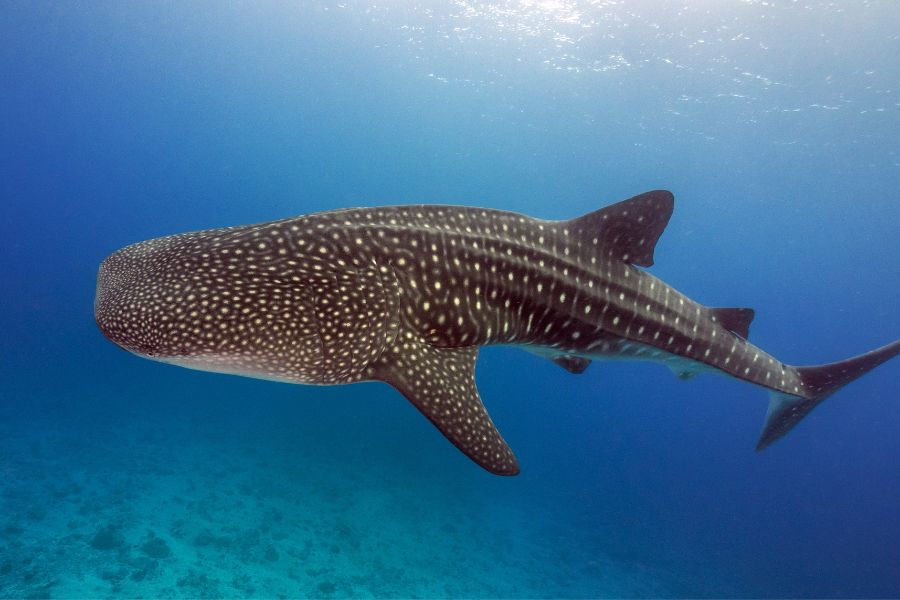
- Size: Up to 15 meters
- Where they are found? Similan Islands, Chumphon and Koh Tao
- What do they eat? plankton
- Are they dangerous? no
Whale sharks, scientifically known as Rhincodon typus, are often referred to as the gentle giants of the ocean, and are the largest living fish species.
They are most notable for their broad head and spotted coloration, which makes them instantly recognizable.
They have a flattened head with a blunt snout above their mouth, which features short barbels protruding from their nostrils.
Despite their massive size, they are not aggressive toward humans and do not pose a threat. In fact, they are usually indifferent to divers and show no signs of aggression.
However, accidental blows from their powerful tails can cause serious injuries so if you’re diving, keep your distance.
Whale sharks are slow swimmers and migrate long distances. They like to inhabit warm waters, and are most commonly found in Thailand’s Gulf Region.
They are generally solitary animals, except during mating season when they come together.
2. Black Tip Reef Shark
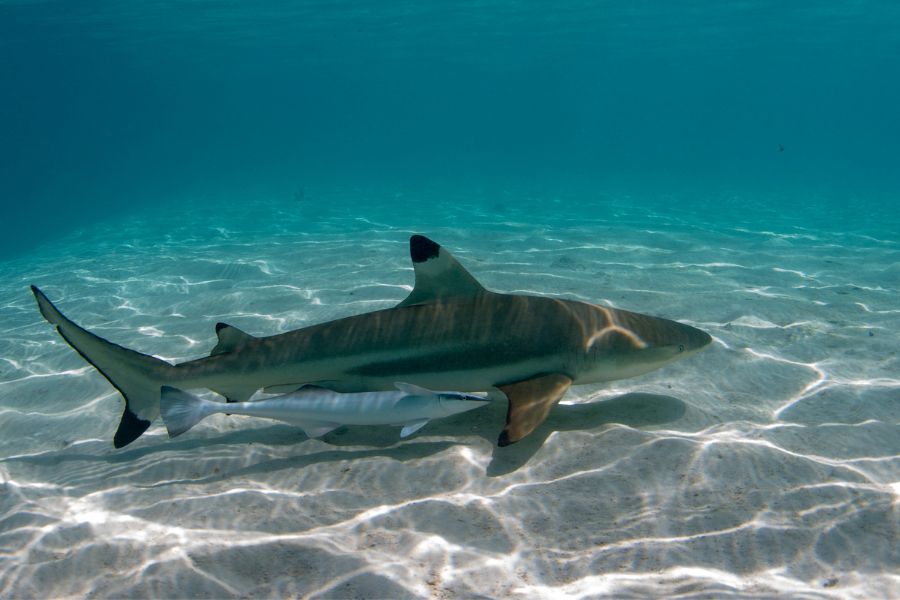
- Size: between 1.6 – 2 meters long
- Where they are found? Maya Bay and The Phi Phi Islands, Koh Tao (specifically Shark Bay which is named after it’s Black Tip population), and the Similan Islands.
- What do they eat? small bony fish, octopus, crabs.
- Are they dangerous? no
The Black Tip Reef Shark, scientifically known as Carcharhinus melanopterus, are one of the more common sharks you’ll find in Thailand, and are one of the few species you can see within swimming distance of the shore.
They are known as sleek predators and derive their name from the distinctive black tips on their fins, which contrast strikingly with their greyish-brown body coloration.
They can be found in the warm coastal waters of the Indo-Pacific region, particularly around coral reefs. Therefore you can find them in the Phi Phi Islands, Koh Tao and the Similan Islands.
In fact, Maya Bay in the Phi Phi Islands was closed for four years to help the environment resettle, which bought back the Black Tip Reef Shark to the bay. Now, you are not allowed to swim in the bay for fear of hurting them.
They are also known for their agility and speed, and their slender body shape is streamlined for fast swimming, making them excellent hunters.
Despite their intimidating look, Black Tips are non-aggressive towards humans. However, caution is necessary when encountering these sharks, as they may exhibit territorial behavior if provoked.
Black Tip Reef Sharks are social animals and often swim in groups, creating an impressive sight in their natural habitat.
3. Nurse Shark & Tawny Nurse Shark
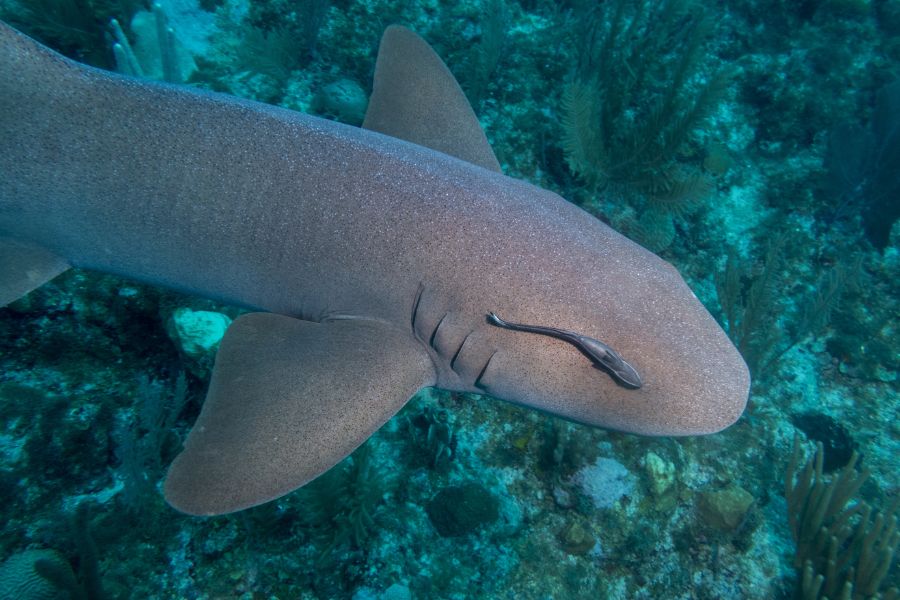
- Size: between 2.2 meters and 2.7 meters
- Where they are found? Mostly the Similan Islands
- What do they eat? small boney fish, spiny lobsters, crustaceans, small stingrays, squid, and sea urchins
- Are they dangerous? no
Nurse sharks, scientifically known as Ginglymostoma cirratum, are one of the smaller sharks in Thailand. They are slow-moving carpet sharks, meaning they prefer to swim on the ocean floor, and have a broad head with a rounded snout, giving them a unique appearance.
They are typically solid brown, with smooth skin and a flattened body. Nurse sharks have two rounded dorsal fins and rounded pectoral fins.
One distinguishing feature of nurse sharks is the presence of barbells – fleshy appendages below their nostrils that provide a sense of touch.
They are generally docile creatures though are capable of short bursts of speed. Unlike most sharks, nurse sharks do not have to constantly swim to breathe. These fascinating creatures are one of the most sought after for divers to swim with due to their gentle nature.
4. Whitetip Reef Shark
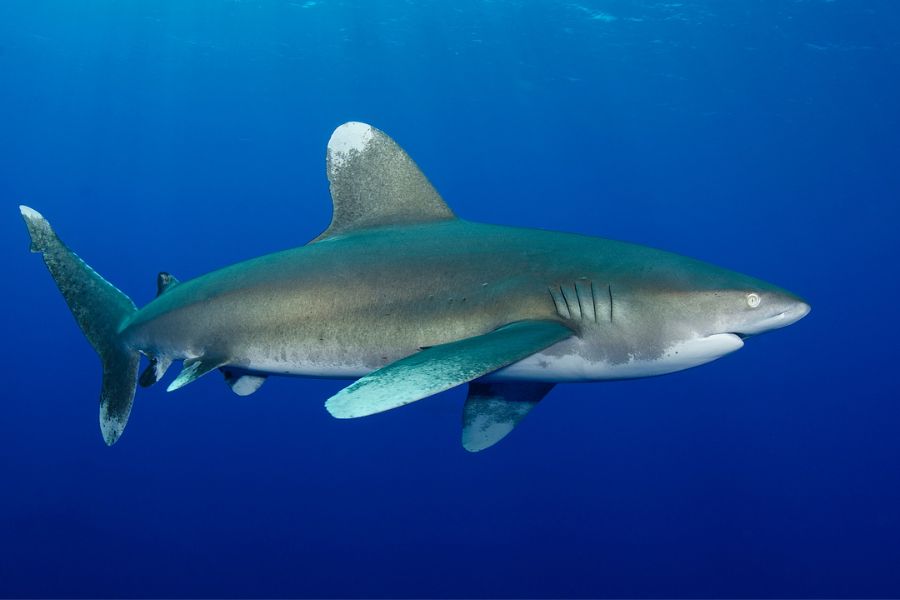
- Size: between 1.6 meters and 2.1 meters long
- Where they are found? Usually off the coast of the islands in Thailand with coral habitats, such as the Phi Phi Islands, Similan Islands, and Koh Tao. They prefer clear, open and deep water.
- What do they eat? crustaceans, octopus and reef fish
- Are they dangerous? no
The Whitetip Reef Shark, scientifically known as Triaenodon obesus, are found in the warm tropical waters of the Indo-Pacific region.
They are known for their slender body with short, rounded fins and a distinctive white-tipped dorsal fin. Their coloration allows them to blend seamlessly with their coral reef habitats.
Whitetip Reef Sharks have nocturnal hunting behavior, actively foraging for fish, crustaceans, and octopuses under the cover of darkness. They are excellent hunters, using their keen senses and agility to locate prey.
Despite their aggressive appearance, they are generally not a threat to humans, though are sometimes curious about divers. They may sometimes go after fishermen’s catch, since they eat snapper fish.
These sharks often rest during the day in caves or under ledges, forming groups known as “shark aggregations.” This unique behavior showcases their social nature and allows divers to observe them in their natural habitat.
5. Zebra Shark

- Size: on average about 2 meters long
- Where they are found? Most commonly found in Koh Bon Pinnacle and Koh Tachai
- What do they eat? small fish, mollusks and crustaceans.
- Are they dangerous? no
The Zebra Shark, also known as Stegostoma fasciatum, is one of the most docile members of the shark family in Thailand.
They have a distinctive appearance with a pattern of dark stripes on its body when young (hence the name, zebra), which gradually transform into spots as they mature. Sometimes they are called Leopard Sharks because of their spotty adult bodies.
Zebra Sharks have a long, slender body with a flattened head and tail, making them excellent swimmers. They are primarily found in the warm waters of the Indo-Pacific region, including coral reefs and sandy seabeds.
Like the Whitetip Reef Shark, they are nocturnal hunters, often feeding on crustaceans, mollusks, and small fish.
A fascinating behavior of the Zebra Shark is that they rest on the ocean floor, using their pectoral fins to prop themselves up, resembling a “sleeping” position. This allows them to conserve energy during the day and save energy for hunting at night.
6. Tiger Shark
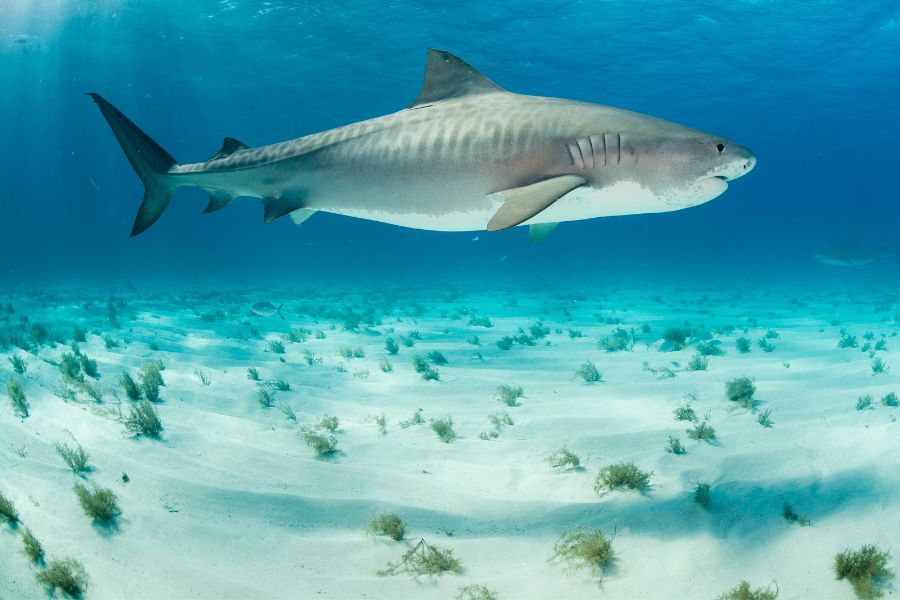
- Size: between 3.5 to 4.7 meters
- Where they are found? Similan Islands
- What do they eat? crustaceans and shellfish, squid, small bony fish, other small sharks, skates, rays, marine birds, porpoises, turtles, seals, and other ocean mammals.
- Are they dangerous? yes
The Tiger Shark, scientifically known as Galeocerdo cuvier, is one of the most dangerous sharks in the world and is known to fatally attack humans. Fortunately, their numbers in Thailand are very small, and are rarely spotted in the country’s waters. The last known sighting was in 2020 by a diver in the Similan Islands.
Named after its distinctive tiger-like stripes, this apex predator is known for its voracious appetite and wide-ranging diet. With a large, robust body and a broad head, Tiger Sharks have powerful jaws filled with sharp, serrated teeth perfectly adapted for tearing through prey.
They are found in warm tropical waters around the world, including coastal areas and offshore reefs. Tiger Sharks display remarkable hunting behavior, often patrolling their territories and scavenging for food.
They are known to consume a wide variety of prey, ranging from fish and turtles to seals and even garbage. This opportunistic feeding behavior has earned them the reputation of “garbage cans of the sea.”
Despite their ferocious appearance and bad reputation, Tiger Sharks typically avoid humans, unless provoked.
7. Bull Shark
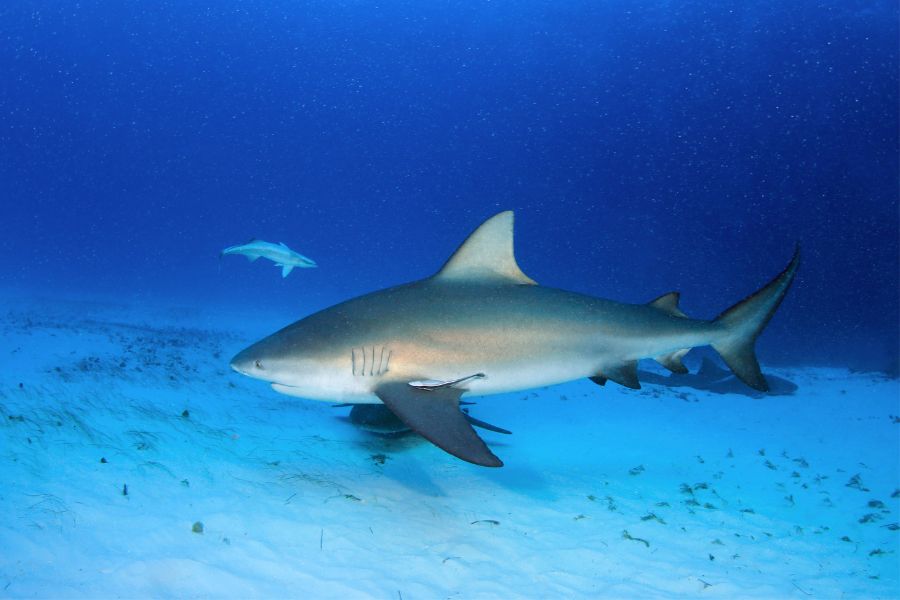
- Size: between 2.1 and 3.5 meters long
- Where they are found? Chumphon Pinnacle near Koh Tao
- What do they eat? fish, turtles, sea birds, and even other sharks
- Are they dangerous? yes
The Bull Shark, scientifically known as Carcharhinus leucas, is another one of the most dangerous animals in Thailand.
Unlike most sharks, the Bull Shark is capable of surviving in both saltwater and freshwater environments, thanks to its ability to regulate its body’s salt content. This remarkable adaptation enables them to navigate rivers, lakes, and even estuaries, making them one of the few species capable of such versatility.
Bull Sharks have a robust and muscular body with a blunt snout and powerful jaws filled with triangular teeth.
They are skilled hunters, known for their aggressive nature and tenacious feeding behavior. Bull Sharks are also known to exhibit territorial behavior, often defending their hunting grounds and mating areas.
Because they can find their way into rivers and tributaries, and they are very territorial, they are the most dangerous shark for humans to watch out for.
8. Grey Reef Shark
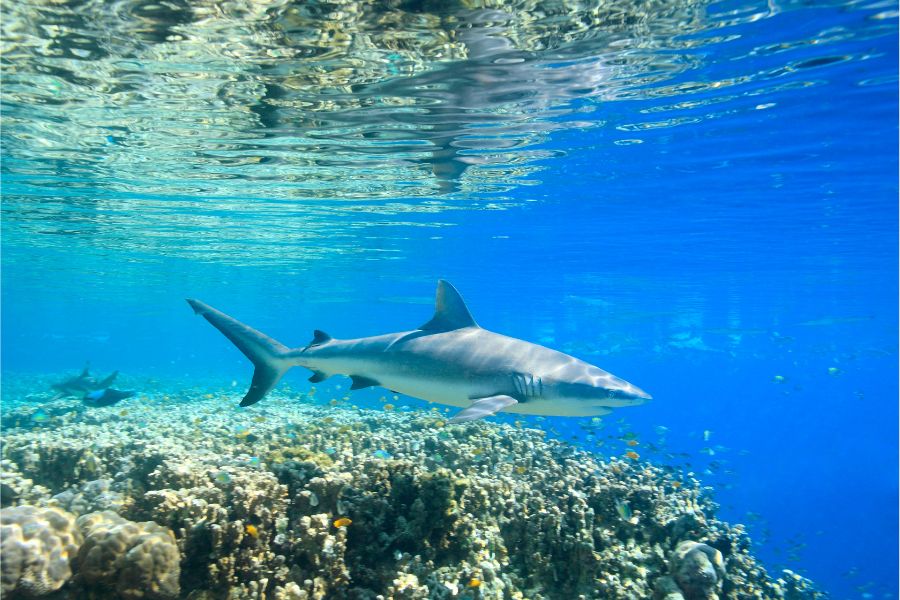
- Size: between 1.2 and 1.4 meters long
- Where they are found? Similan Islands (though sightings are rare)
- What do they eat? reef fish,cephalopods (squid and octopus), and crustaceans
- Are they dangerous? not unless cornered or threatened
The Grey Reef Shark, scientifically known as Carcharhinus amblyrhynchos, are named after their preferred habitat, the coral reefs of the Indo-Pacific region.
With a streamlined body and a prominent dorsal fin, Grey Reef Sharks are agile swimmers, capable of swiftly maneuvering through underwater obstacles. They have a distinct grey coloration, blending seamlessly with the reef surroundings.
These sharks are highly social creatures and often form small groups called “shoals” or “pods.” Within these groups, they display a hierarchy where dominant individuals maintain territories and assert their dominance during feeding and mating.
They are not common in Thailand, with sightings being quite rare. They are known to be curious animals and have shown signs of aggressive behavior, and even attack human attacks. They are usually safe to swim with, but should not be approached and observed from a distance by divers.
When they feel threatened, they raise their snout, arch their back, and lower their fins, before swimming in an exaggerated way.
9. Hammerhead Shark & Great Hammerhead Shark
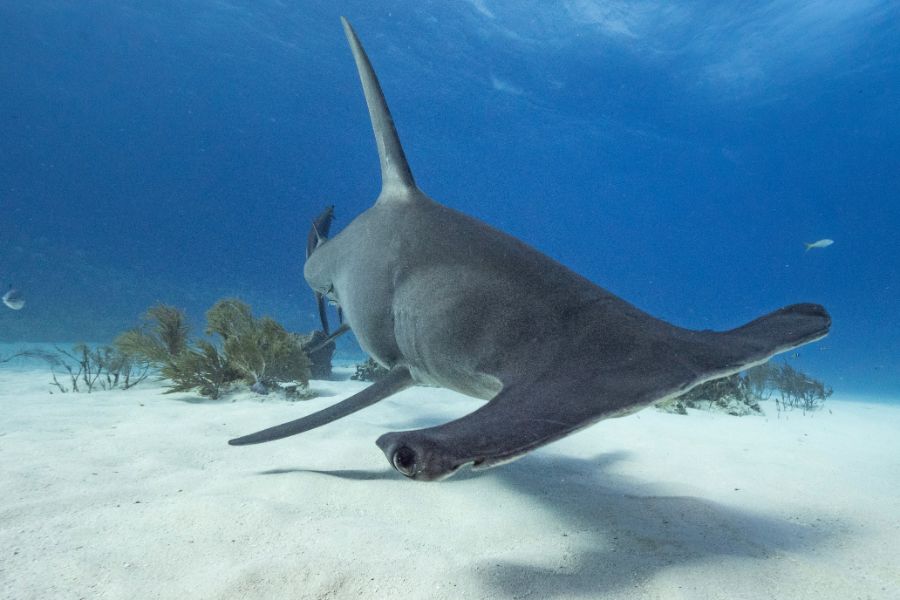
- Size: Up to 4.5 meters
- Where they are found? In the Andaman Sea, particularly around Krabi, Koh Lanta and Koh Jum.
- What do they eat? stingrays and rays, skates, smaller sharks, small boney fish, squid and bottom dwelling crustaceans.
- Are they dangerous? no
The Hammerhead Shark, scientifically known as Sphyrnidae, is famous for its distinct and uniquely shaped head, which resembles a hammer or a T-shaped structure, known as the cephalofoil.
This extraordinary adaptation allows for enhanced sensory perception, as it provides a wider field of vision and improved electroreception to detect prey buried in the sand.
Hammerhead Sharks are highly skilled hunters, utilizing their specialized head to pin down and maneuver prey more effectively.
These sharks are also known for their social behavior, often forming large schools during migration or mating seasons.
Additionally, they engage in courtship rituals where males display aggressive behavior to attract females.
10. Silvertip Shark
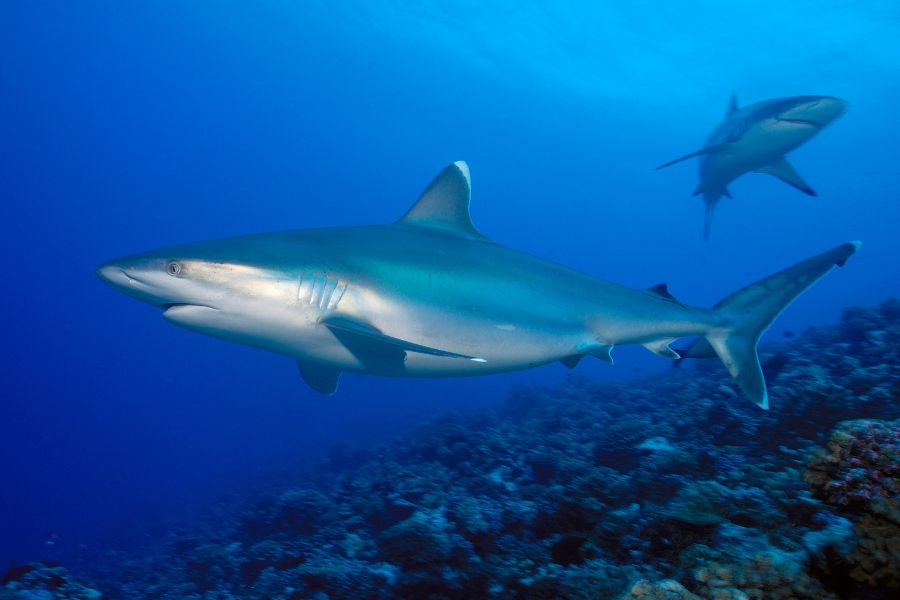
- Size: Up to 3 meters
- Where they are found? Burma Banks in the Andaman Sea.
- What do they eat? small bony fish, rays, octopuses, squids, other small sharks, and crustaceans
- Are they dangerous? treated as potentially dangerous due to their size
The Silvertip Shark, scientifically known as Carcharhinus albimarginatus, is named for the striking silver tips on its dorsal fins, and is highly adapted to its oceanic habitat. With a streamlined body and long, slender pectoral fins, Silvertip Sharks are swift and agile swimmers, allowing them to effortlessly navigate through the open waters.
They have a preference for deep-sea environments though are often found near coral reefs and drop-offs.
These sharks are primarily solitary creatures, rarely forming large social groups.
Known for their inquisitive nature, Silvertip Sharks often approach divers and explorers, demonstrating a curious yet cautious behavior. They are considered dangerous because they silently creep up on divers, though only one unprovoked attack by a Silvertip Shark has been known to happen.
FAQs About Sharks in Thailand
Are sharks common in Thailand?
Thailand does have a diverse range of shark species, but the presence of sharks in Thai waters is not considered common compared to other regions. While there are several species, encountering them is usually limited to specific locations and requires journeying far away from land to see them (with the exception of black tip reef sharks in Koh Tao).
Are sharks a problem in Thailand?
Sharks are not considered a significant problem in Thailand. While there are various shark species present in Thai waters, most of them are harmless and pose little threat to humans. Encounters with dangerous sharks are rare, and the chances of an attack are extremely slim.
Does Phuket Thailand have sharks?
Phuket is home to various shark species, including whitetip reef sharks, blacktip reef sharks, leopard sharks, and even the majestic whale sharks. However, the likelihood of seeing a shark from the water is slim, and usually requires you to journey out to sea or to the Phi Phi Islands to see and dive with them.
Does Koh Samui have sharks?
Koh Samui is home to a variety of shark species, including leopard sharks, blacktip reef sharks, and whale sharks. While encounters with these sharks are not guaranteed, they have been occasionally spotted in the waters around Koh Samui, though seeing them from the shore is a rare sight.
How big are sharks in Thailand?
Sharks in Thailand vary in size depending on the species. The average size of sharks in Thailand range from 1-2 meters, up to 15 meters.
Final Thoughts
Thailand has some of the most beautiful shark species in the world, from the magestic zebra shark to the iconic blacktip reef shark, and even magnificent gentle giant the whale shark.
However, although fearsome predators like the great white shark are not found in Thai waters, diving enthusiasts are always asked to be cautious when swimming with these animals.
Always listen to your dive master for instructions on what to do in the waters with these creatures.
